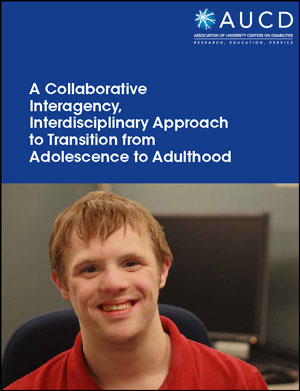A Collaborative Interagency, Interdisciplinary Approach to Transition from Adolescence to Adulthood
May 24, 2013

|
| Download |
|
|
Introduction
As youth with intellectual and developmental disabilities (IDD) leave school, they face several transitions including school to work or postsecondary education, family home to community living, and child oriented health care to adult care. Youth should be able to expect self-determined transitions with coordinated support from family, community, professionals, and agencies, but they and their families often experience very little choice, control, or collaboration from the myriad of systems to which they look for support and services for transition.
Multiple barriers stand in the way of a coordinated approach to supporting all aspects of successful transition to adulthood. These barriers include failing to support self-determination as a central element of the person-centered process of transition; insufficient understanding of the role of culture in an individual or family's concept or approach to transition; the tendency for professionals within each transition domain (education, health, community living, employment, others) to use language that is not easily understood by other professionals, youth, families, or other community partners; and neglecting to specifically explore how transition in the different realms could/should be linked for maximizing success.
To that end, this paper promotes four core concepts that are essential to the development and implementation of effective transition plans and process.
- Self-determination should be the foundation for transition planning.
- Transition should be viewed through a cultural lens.
- Interagency collaboration is essential to effective transition.
- Transition planning should include all the perspectives, disciplines, and organizations that will impact the transitioning student.
Purpose
This paper was written for and by directors and staff of the networks of University Centers for Excellence in Developmental Disabilities Centers and the Leadership Education in Neurodevelopmental Disabilities programs. It is intended for faculty, staff, trainees, individuals with disabilities, and family members in these two networks as well as policy makers and partners in local and state disability organizations and agencies. The paper aims to promote a dialogue among key stakeholders and to facilitate their engagement in pursuing a more comprehensive, coordinated, supportive, and successful transition process for youth with disabilities from adolescence to young adulthood.
Resources
Along with the four core concepts essential to the development and implementation of effective transition plans and process, the authors of this document provide several pages of resources from the AUCD network. The focus of these resources are not on the projects that have a single agency or single discipline approach to transition but rather on initiatives that promote and utilize interdisciplinary practice. This 2012-2013 list of programs or projects that are quality examples of collaborations to transition and additional transition-related resources are included in the publication and are also available here.
Authors
- A. Anthony Antosh, EdD: Paul V. Sherlock Center on Disabilities, Rhode Island College
- Martin Blair, PhD: Center for Persons with Disabilities, Utah State University
- Karen Edwards, MD, MPH: LEND Program at Cincinnati Children's Hospital and the University of Cincinnati
- Tawara Goode, MA: Georgetown UCEDD, Georgetown University
- Amy Hewitt, PhD, MSW: Institute on Community Integration and MN LEND, University of Minnesota
- Margaretha Izzo, PhD: Nisonger Center, The Ohio State University
- David R. Johnson, PhD: Institute on Community Integration, University of Minnesota
- Olivia Raynor, PhD: Tarjan Center, University of California Los Angeles
- Ilka Riddle, PhD: University of Cincinnati University Center for Excellence in Developmental Disabilities, University of Cincinnati
- Judy L. Shanley, PhD: Easter Seals
- Royal Walker, Jr., JD: Institute for Disability Studies, University of Southern Mississippi
- Michael Wehmeyer, PhD: Kansas University Center on Developmental Disabilities, University of Kansas
- Several youth and family members offered input and comments
Ordering Information
- PDF copies of this document may be downloaded from the box at right at no charge.
- The resource section only is available electronically here.
- To order a bound hard copy of this document for $10 per piece plus shipping, please complete the order form at right and return it, with payment, to AUCD at the address listed on the form.
Companion Document
"A Comprehensive Approach to Transition" was created in a workbook format geared at individuals with disabilities as they think through the transition process and is a companion document to this one. View "A Comprehensive Approach to Transition" and download or order it here for $6/piece plus shipping.







